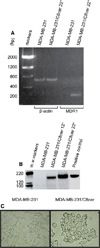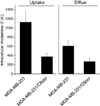Ceramide and glucosylceramide upregulate expression of the multidrug resistance gene MDR1 in cancer cells
- PMID: 18035065
- PMCID: PMC3569095
- DOI: 10.1016/j.bbalip.2007.09.005
Ceramide and glucosylceramide upregulate expression of the multidrug resistance gene MDR1 in cancer cells
Abstract
In the present study we used human breast cancer cell lines to assess the influence of ceramide and glucosylceramide (GC) on expression of MDR1, the multidrug resistance gene that codes for P-glycoprotein (P-gp), because GC has been shown to be a substrate for P-gp. Acute exposure (72 h) to C8-ceramide (5 microg/ml culture medium), a cell-permeable ceramide, increased MDR1 mRNA levels by 3- and 5-fold in T47D and in MDA-MB-435 cells, respectively. Acute exposure of MCF-7 and MDA-MB-231 cells to C8-GC (10 microg/ml culture medium), a cell-permeable analog of GC, increased MDR1 expression by 2- and 4- fold, respectively. Chronic exposure of MDA-MB-231 cells to C8-ceramide for extended periods enhanced MDR1 mRNA levels 45- and 390-fold at passages 12 and 22, respectively, and also elicited expression of P-gp. High-passage C8-ceramide-grown MDA-MB-231 (MDA-MB-231/C8cer) cells were more resistant to doxorubicin and paclitaxel. Incubation with [1-(14)C]C6-ceramide showed that cells converted short-chain ceramide into GC, lactosylceramide, and sphingomyelin. When challenged with 5 mug/ml [1-(14)C]C6-ceramide, MDA-MB-231, MDA-MB-435, MCF-7, and T47D cells took up 31, 17, 21, and 13%, respectively, and converted 82, 58, 62, and 58% of that to short-chain GC. Exposing cells to the GCS inhibitor, ethylenedioxy-P4, a substituted analog of 1-phenyl-2-hexadecanoylamino-3-pyrrolidino-1-propanol, prevented ceramide's enhancement of MDR1 expression. These experiments show that high levels of ceramide and GC enhance expression of the multidrug resistance phenotype in cancer cells. Therefore, ceramide's role as a messenger of cytotoxic response might be linked to the multidrug resistance pathway.
Figures








Similar articles
-
Expression of P-glycoprotein in HeLa cells confers resistance to ceramide cytotoxicity.Int J Oncol. 2010 Dec;37(6):1591-7. doi: 10.3892/ijo_00000813. Int J Oncol. 2010. PMID: 21042729
-
SDZ PSC 833 the drug resistance modulator activates cellular ceramide formation by a pathway independent of P-glycoprotein.Cancer Lett. 2000 Feb 28;149(1-2):143-51. doi: 10.1016/s0304-3835(99)00353-5. Cancer Lett. 2000. PMID: 10737718
-
P-glycoprotein antagonists confer synergistic sensitivity to short-chain ceramide in human multidrug-resistant cancer cells.Exp Cell Res. 2011 Jul 15;317(12):1736-45. doi: 10.1016/j.yexcr.2011.03.004. Epub 2011 Mar 21. Exp Cell Res. 2011. PMID: 21396934 Free PMC article.
-
The UDP-glucose ceramide glycosyltransferase (UGCG) and the link to multidrug resistance protein 1 (MDR1).BMC Cancer. 2018 Feb 6;18(1):153. doi: 10.1186/s12885-018-4084-4. BMC Cancer. 2018. PMID: 29409484 Free PMC article. Review.
-
Structure, function and regulation of P-glycoprotein and its clinical relevance in drug disposition.Xenobiotica. 2008 Jul;38(7-8):802-32. doi: 10.1080/00498250701867889. Xenobiotica. 2008. PMID: 18668431 Review.
Cited by
-
Gaucher's disease and cancer: a sphingolipid perspective.Crit Rev Oncog. 2013;18(3):221-34. doi: 10.1615/critrevoncog.2013005814. Crit Rev Oncog. 2013. PMID: 23510065 Free PMC article. Review.
-
Dynamics of ceramide generation and metabolism in response to fenretinide--Diversity within and among leukemia.Leuk Res. 2015 Oct;39(10):1071-8. doi: 10.1016/j.leukres.2015.06.009. Epub 2015 Jul 2. Leuk Res. 2015. PMID: 26220867 Free PMC article.
-
Interdiction of Sphingolipid Metabolism Revisited: Focus on Prostate Cancer.Adv Cancer Res. 2018;140:265-293. doi: 10.1016/bs.acr.2018.04.014. Epub 2018 Jun 20. Adv Cancer Res. 2018. PMID: 30060812 Free PMC article. Review.
-
Evaluation of bioactive sphingolipids in 4-HPR-resistant leukemia cells.BMC Cancer. 2011 Nov 7;11:477. doi: 10.1186/1471-2407-11-477. BMC Cancer. 2011. PMID: 22061047 Free PMC article.
-
The Critical Impact of Sphingolipid Metabolism in Breast Cancer Progression and Drug Response.Int J Mol Sci. 2023 Jan 20;24(3):2107. doi: 10.3390/ijms24032107. Int J Mol Sci. 2023. PMID: 36768427 Free PMC article. Review.
References
-
- Gottesman MM. Mechanisms of cancer drug resistance. Annu. Rev. Med. 2002;53:615–627. - PubMed
-
- Ueda K, Cornwell MM, Gottesman MM, Pastan I, Roninson IB, Ling V, Riordan JR. The mdr1 gene, responsible for multidrug-resistance, codes for P-glycoprotein. Biochem. Biophys. Res. Commun. 1986;141:956–962. - PubMed
-
- Peel SA. The ABC transporter genes of Plasmodium falciparum and drug resistance. Drug Resist. Updat. 2001;4:66–74. - PubMed
-
- Ouellette M, Legare D, Haimeur A, Grondin K, Roy G, Brochu C, Papadopoulou B. ABC transporters in Leishmania and their role in drug resistance. Drug Resist. Updat. 1998;1:43–48. - PubMed
-
- Gouaze V, Yu JY, Bleicher RJ, Han TY, Liu YY, Wang H, Gottesman MM, Bitterman A, Giuliano AE, Cabot MC. Overexpression of glucosylceramide synthase and P-glycoprotein in cancer cells selected for resistance to natural product chemotherapy. Mol. Cancer Ther. 2004;3:633–639. - PubMed
Publication types
MeSH terms
Substances
Grants and funding
LinkOut - more resources
Full Text Sources
Miscellaneous

